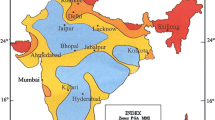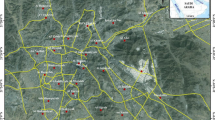Abstract
Background, aim, and scope
The rapid growth of the world’s population over the past few decades has led to a concentration of people, buildings, and infrastructure in urban areas. The tendency of urban areas to develop in sedimentary valleys has increased their vulnerability to earthquakes due to the presence of soft soil and sediment. Several earthquakes have clearly demonstrated that local soil and sediment conditions can have a significant influence on earthquake-induced ground motion and damage pattern, respectively. Many studies confirm the relationship between site effect and ground motion (Borcherdt in Bull Seismol Soc Am 60:29–61, 1970; Bouckovalas et al. in Geotech Geolog Eng (Historical Archive) 14(2):111–128, 1996; Fäh et al. in Seismology 1:87–10, 1997; Atakan et al. in Nat Hazards 15(2–3):139–164, 1997; Christaras et al. in Geodynamics 26(2–4):393–411, 1998; Raptakis et al. in Bull Earthquake Eng 2(3):285–301, 2004a; Raptakis et al. in Soil Dyn Earthq Eng 25:871–887, 2005; Marka et al. in Pure Appl Geophys 158:2349–2367, 2001; Marka et al. in Soil Dyn Earthq Eng 25(4):303–315, 2005; Importa et al. in Seismology 9(2):191–210, 2005; Tyagunov et al. in Nat Hazards 38:199–214, 2006; Lombardo et al. in Nat Hazards 38:339–354, 2006; Rayhani et al. in Geotech Geol Eng 21(1):91–100, 2008). In order to classify the suitability of the soil and subsurface sediment units for urban planning and compare their mechanical behavior with the non-uniform damage observed in the 2003 earthquake, we performed some geotechnical and geophysical analyses of soil and sediment samples collected from different locations in Bam City.
Methodology
Geophysical and geotechnical properties, such as grain size distribution, sorting, plasticity, Poison’s ratio, shear strength, compression index, permeability, and P and S wave velocities in soil and subsurface sediments, were measured. Maps (in GIS environment) and cross-sections were prepared for the study area.
Results
According to our observations, a great number of buildings were damaged in areas of the city where silty and clayey soils dominate, presenting very low permeability, low wave velocity together with high plasticity, and compressibility. In the study area, we recognized eight sediment types. Shear wave propagation velocities allowed for the identification of four seismic layers referred to as the surface layer, second layer, and third layer and seismic bedrock. We found that the damages observed in the Bam area were related to the physical and mechanical properties of the soil and subsurface sediment units. We also found that the soil thickness that was estimated by geophysical surveying shows a direct relationship with damage rate observations. Furthermore, we observed that landslide and qanat collapses have occurred in some areas where sand and silty sand soils and subsurface sediments dominate.
Discussion
The distribution of the damage shows a microzonation that is very serious in some points in the city along the main fault, especially where it is located on thick, fine, medium, and loose soil and sediments. In general, there is a discernable west to east increase in the damage across the city. The average level of destruction for the entire city was ~75%, while the eastern part of the city locally reached 100% destruction level. The major factors that influenced the damage and destruction in the Bam region were the distance of a given site from the seismic source, the quality of foundation soil and subsurface sediment, and the type of building. The Bam earthquake occurred on a single fault network comprising the Bam and Arg-e-Bam faults (Funning et al. in J Geophys Res 100(B09406):1–23, 2005). The sediments and soil of the area (unconsolidated silty sand and sandy gravel) belong to braided fluvial and alluvial facies. Most of the buildings near the epicenter area were old and constructed of mud bricks using mud cement.
Recommendations and perspectives
A combined sedimentological, geological, neotectonic, geotechnical, paleoseismological, and geophysical investigation in urban areas (especially in alluvial valleys) will give the detailed knowledge of the subsurface structure required for the accurate and precise seismic hazard assessments needed for effective earthquake protection planning. This paper shows that for the Bam situation, sedimentological data are required to provide an interpretive context for the geophysical data.




Similar content being viewed by others
References
Ambraseys N, Melville C (1982) A history of Persian earthquakes. Cambridge University Press, Cambridge, UK
ASTM (1989) Sec. 4 construction. Annual book of ASTM standards. V04.08 Soil and Rock Building Stone Geotextiles, Philadelphia
Atakan K, BrandsdÓttir B, HalldÓrsson P, Fridleifsson GO (1997) Site response as a function of near-surface geology in the South Iceland seismic zone. Nat Hazards 15(2–3):139–164
Bauer E, Tejchman J (1998) Influence of density, pressure and mean grain diameter on shear band localization in granular material. Proceedings of the 3rd International conference on Mechanic of Faulted Rock, Wien, Austria, 6–9 April 1998. Balkema, pp 151–156
Bauer E, Huang W, Wu W (2004) Investigations of shear banding in an anisotropic hypoplastic material. Int J Solids Struct 41:5903–5919
Berberian M (2005) The 2003 Bam urban earthquake: a predictable seismotectonic pattern along the western margin of the rigid Lut block, Southeast Iran. Earthq Spectr 21:35–99
BHRC (2005) Seismic microzonation project for Bam city. Building and Housing Research Center, Iran, N-101547-V.1
Borcherdt RD (1970) Effects of local geology on ground motion near San Francisco Bay. Bull Seismol Soc Am 60:29–61
Bouckovalas G, Anagnostopoulos A, Kapenis A, Karantoni T (1996) Analysis of soil effects and distribution of damage from the Pyrgos 1993 (Greece) earthquake. Geotech Geolog Eng (Historical Archive) 14(2):111–128
Christaras B, Dimitriou A, Lemoni H (1998) Soil quality as a factor of the distribution of damages at the meizoseismal area of the Kozani-Grevana 1995 earthquake, in Greece (M s = 6.6). Geodynamics 26(2–4):393–411
Ding Z, Chen YT, Panza GF (2004) Estimation of site effects in Beijing City. Pure Appl Geophys 161(5–6):1107–1123
Fäh D, Rüttener E, Noack Th, Kruspan P (1997) Microzonation of the city of Basal. Seismology 1:87–10
Folk RL (1966) Areview of grain size parameters. Sedimentology 6:73–93
Funning GJ, Parsons B, Wright T, Jackson JA, Fielding EJ (2005) Surface displacements and source parameters of the 2003 Bam earthquake from ASAR. J Geophys Res 100(B09406):1–23
Ghafory-Ashtiany M, Hosseini M (2008) Post-Bam earthquake: recovery and reconstruction. Nat Hazards 44:229–241
Hassami Kh, Tabbassi H, Abbassi MR, Azuma T, Okumura K, Echigo T, Kondo H (2004) Surface expression of the Bam fault zone in southeastern Iran: causative fault of the December 26, 2003 earthquake. JSEE Spring 5(4):1–10
Hoseini A, Ghafouri M, Lashkaripour MA (2005) Geotechnical investigation of soils in Bam city. MSc thesis, Department of Geology, Ferdowsi University Mashhad, pp 160 (in Persian)
IAEG (1981) Rock and soil description and classification for engineering geological mapping report by the IAEG Commission on engineering geological mapping. Bull IAEG 24:235–274
Improta L, Di Giulio G, Rovelli A (2005) Variations of local seismic response in Benevento (Southern Italy) using earthquakes and ambient noise recordings. Seismology 9(2):191–210
Jafari MK, Ghayamghamian MR, Davoodi M, Kamalian M, Sohrabi-Bidar A (2005) Site effects of the 2003 Bam, Iran earthquake. J Seismol Inst Iran 22:1–18
Jafargandomi A, Fatemi aghda SM, Suzuki S, Nakamura T (2004) Strong ground motions of the 2003 Bam earthquake SE Iran (M w = 6.5). Bull Earthqu Res Inst Univ Tokyo 79:47–57
Lewis DW, McConchie D (1994) Analytical sedimentology. Chapman and Hall, London
Lombardo G, Langer H, Gresta S, Rigano R, Monaco C, Deguidi G (2006) On the importance of geolithological features for the estimate of the site response: the case of Catania Metropolitan area (Italy). Nat Hazards 38:339–354
Luzi L, Bindi D, Franceschina G, Pacor F, Castro RR (2005) Geotechnical site characterisation in the Umbria-Marche area and evaluation of earthquake site-response. Pure Appl Geophys 162(11):2133–2161
Marka K, Raptakis D, Chavez-Garcia FJ, Pitilakis K (2001) Site effects and design provisions: the case of Euroseistest. Pure Appl Geophys 158:2349–2367
Marka K, Chavez-Garcia FJ, Raptakis DG, Pitilakis KD (2005) Parametric analysis of the seismic response of a 2D sedimentary valley: implications for code implementations of complex site effects. Soil Dyn Earthqu Eng 25(4):303–315
Nadim F, Moghtaderi-Zadeh M, Lindholm C, Andresen A, Remseth S, Bolourchi M, Mokhtari M, Tvedt E (2004) The Bam earthquake of 26 December 2003. Bull Earthqu Eng 2(2):119–153
Nakamura T, Suzuki S, Sadeghi H, Fatemi Aghda SM, Matsushima T, Ito Y, Hosseini SK, Jafar Gandomi A, Maleki M (2005) Source fault structure of the 2003 Bam earthquake, southeastern Iran, inferred from aftershock distribution and its relation to heavily damaged area: existence of the Arg-e-Bam fault proposed. Geophys Res Lett 32:L09380
Pacor F, Bindi D, Luzi L, Parolai S, Marzorati S, Monachesi G (2007) Characteristics of strong ground motion data recorded in the Gubbio sedimentary basin (Central Italy). Bull Earthqu Eng 5:27–43
Raptakis D, Makra K, Anastasiadis A, Pitilakis K (2004a) Complex site effects in Thessaloniki (Greece): I. Soil structure and comparison of observations with 1D analysis. Bull Earthqu Eng 2(3):285–301
Raptakis D, Makra K, Anastasiadis A, Pitilakis K (2004b) Complex site effects in Thessaloniki (Greece): II. 2D SH modeling and engineering insights. Bull Earthqu Eng 2(3):301–327
Raptakis DG, Manakov MV, Chavez-Garcia FJ, Makra KA, Pitilakis KD (2005) 3D configuration of Mygdonian basin and preliminary estimate of site response. Soil Dyn Earthqu Eng 25:871–887
Rayhani MHT, El Naggar MH, Tabatabi SH (2008) Nonlinear analysis of local site effects on seismic ground response in the Bam earthquake. Geotech Geolog Eng 21(1):91–100
Satoh T, Kawase H, Iwata T, Higashi S, Sato T, Huang HCh (2004) S-wave velocity structures of sediments estimated from array microtermor records and site responses in the near-fault region of the 1999 Chi-Chi, Taiwan earthquake. J Seismol 8:545–558
Talebian M, Fielding EJ, Funning GJ, Ghorashi M, Jackson J, Nazari H, Parsons B, Priestly K, Rosen PA, Walker R, Wright TJ (2004) The 2003 Bam(Iran) earthquake: rupture of a blind strike-slip fault. Geophys Res Lett 31:L11611,4
Tejchman J, Bauer E, Tantono SF (2007) Influence of initial density of cohesion less soil on evolution of passive earth pressure. J Acta Geotechnica 2:53–63
Tertulliani A, Maramai A (1998) Macroseismic evidence and site effects for the Lunigiana (Italy) 1995 earthquake. Seismology 2(3):209–222
Tyagunov S, Hollnack D, Wenzel F (2006) Engineering–seismological analysis of site effects in the area of Cologne. Nat Hazards 38:199–214
USAE (1953) The unified soil classification system. Tech Memo N3-357, l.1, 30, US Army Engineer Waterways Experiment Station
Weihua L, Chenggang Z, Peixin Sh (2005) Scattering of plane P waves by circular–arc alluvial valleys with saturated soil deposits. Soil Dyn Earthqu Eng 25:997–1014
Yalcinkaya E, Alptekin O (2005) Site effect and its relationship to the intensity and damage observed in the June 27, 1998 Adana-Ceyhan earthquake. Pure Appl Geophys 162:913–930
Author information
Authors and Affiliations
Corresponding author
Additional information
Responsible editor: Philip N. Owens.
Rights and permissions
About this article
Cite this article
Rezaei, K., Guest, B., Friedrich, A. et al. Soil and sediment quality and composition as factors in the distribution of damage at the December 26, 2003, Bam area earthquake in SE Iran (M s = 6.6). J Soils Sediments 9, 23–32 (2009). https://doi.org/10.1007/s11368-008-0046-9
Received:
Accepted:
Published:
Issue Date:
DOI: https://doi.org/10.1007/s11368-008-0046-9




